
 Glaston Technologies’ Bavelloni has launched a completely automated,
Glaston Technologies’ Bavelloni has launched a completely automated,
new generation of cutting lines for both monolithic and laminated
glass, an innovative CNC machine and a new seamer called Powerseam.
 |
Turn ideas into products
Glaston Technologies’ Bavelloni has launched a completely automated, new generation of cutting lines for both monolithic and laminated glass, an innovative CNC machine and a new seamer called Powerseam.
These latest machines offer the best technologies for glass processors looking for profitable growth and the best return on their investment. All products are aimed to meet the highest quality and productivity levels, making it easier and faster to turn customers’ ideas into successful end products.
Process large glass
The modular technology of the complete cutting lines for both monolithic and laminated glass adds flexibility in plant designs. They combine basic elements like Bavelloni’s loaders, cutting tables and breaking tables with increased automation levels, eliminating human error and improving machinery performance. One of the main features for monolithic products is the ability to process large glass sizes for the architectural market.
The new cutting lines for laminated glass include all of the innovations found in LAMY 370 SL, offering several technical aspects which support its use in the architectural market while automating scoring, breaking, heating and glass separation.
 |
Compact CNC machine
The new Bavelloni NRG 250-3 is aimed at offering speed and efficiency in drilling, milling and grinding operations. NRG 250-3 is built on the successful COLIBRÌ 200, the company’s most accurate and fastest CNC edging machine. It is designed to meet all the glass processing requirements as well as demands for space saving and improved price/quality ratio.
Its compact construction incorporates an integrated safety fence with a sliding door and is available with right and left configuration and with a nine position tool store. Its primary application is targetted at glass products for interior design, automotive as well as the appliance industry. Programming is carried out via an integrated graphic interface based on Microsoft XP software and is offered with an optional touch screen and a parametric library of drawings and doors.
Productivity and flexibility
Powerseam is Bavelloni’s new arrising machine, created to feature high productivity and flexibility. Made for all types of glass, Powerseam offers customers high flexibility and automation for different glass sizes. It can be fully integrated into any production line or operated as a stand-alone machine. Designed to reduce the need for glass handling, it supports horizontal working throughout the whole manufacturing process from cutting to tempering and laminating. Powerseam can be connected to other equipment such as a conveyor, washing machine, or a tempering furnace and has also been designed for integration with Tamglass solutions. As it has been designed with an open electrical architecture, it can easily be integrated with other software solutions. -end-
Glaston Technologies: www.glaston.net, www.tamglass.com, www.bavelloni.com
Easier than ever
After launching the Sonic, high speed convection tempering furnace in 2005, Glaston Technologies’ Tamglass has followed up with a new model offering innovations that make it ‘easier than ever’ for tempering Super low-E glass.
In addition to its fast performance and processing speed the latest Sonic reduces processing time, maximizes quality and minimizes breakage rates. This is based on ‘profiled full
convection’ technology, combined with its machine vision based Automatic Process Control (APC) system.
The advantages of the Tamglass Automatic Process Control system include quality and productivity. The system measures key properties of glass, such as thickness, emissivity and glass load by an integrated machine vision technology and automatically creates furnace settings for easy operation. This eliminates many variations of human errors to increase quality. Adjustments to different sizes of glass in the same loading are automatic and waste
production is effectively eliminated.
Excellent processing speed, especially for Super low-E, is guaranteed with the ‘profiled full convection’ heating system that circulates hot air in the process. The Convection Booster units are located outside of the furnace to maximize the life-time of the components and maintenance is easy and fast for more uptime.
This new tempering technology is ideal for glass processors that want a flexible production of architectural and IG glass. The company says the latest ‘profiled convection’ technology
combined with automatic process control starts the next generation of safety glass processing that enables the use of automation on a larger scale. -end-
Glaston Technologies: www.glaston.net, www.tamglass.com, www.bavelloni.com
 |
For drilling flexibility
Glassline Corporation has introduced a new CNC X-Y glass drill with Dual-Head option. This machine was designed specifically for installation in a glass fabrication facility where glass drilling flexibility and speed is critical.
The D1148 drill system is configured for a broad range of part sizes and shapes. The table is specially designed to allow great flexibility. It has an open, adjustable design allowing holes to
be placed nearly anywhere desired. The drill was designed with a special sub-table to ensure accurate support under the glass in the drilling area. For ease of loading, the table travels in the Y axis, toward and away from the load operator.
Configured with two independent drill heads travelling in the X axis, the D1148 drill system allows the simultaneous drilling of two holes at one time. This is beneficial on many common parts that may have hinge holes along one side of the part. The drill heads themselves may be either air power heads or servo powered. The heads are equipped with upper and lower spindles. Automatic stoning is included.
Processing capabilities of the D1148 include a glass size range from 8.0in by 10in, up to 48in by 75in. The drill throat is 30in with usable throat 241⁄4in, hole sizes from 1⁄4in to 21⁄2in capacity. Standard 3⁄8in diameter straight shank drill bit, with optional thread. Machine voltage requirement is 480V AC three phase/24V DC control. Air – 80psi continuous, clean and dry. The machine uses city water. The table height is 40in. -end-
Glassline: (419) 666-5942, www.glassline.com
Flat glass printing
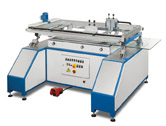 |
Fleischle eKfm has introduced a new semi-automatic screen printing machine, type MP-S, for printing on flat glass that offers short change-over times, easy machine handling, high
productivity and reliability as well as optimal printing results. With this well-proven machine type, the glass panels can be manually loaded directly on the print table and positioned between masks in a three-point alignment system or by using a lifting device so a pre-positioning station is not needed.
The print process gets started by pressing the foot pedal. Printing is done in longitudinal direction from right to left and the pneumatically adjustable squeegee pressure guarantees an equal application of ink. The screen-lift works pneumatically. The safety during the lowering of the machine top is provided by a well-proven safety system. This system works without light barriers and without disturbing contact rails.
The machine type MP-S is drawn up for single pieces as well as for a larger series and guarantees absolute repeatability. The machine is manufactured in four standard sizes having a maximum printing format of 700mm by 1000mm, 1000mm by 1600mm, 1200mm by 2400mm and 1600mm by 2800mm. Glass with a thickness from 1.5mm up to 19mm can be printed. Special sizes are also available for delivery.
Its construction also enables printing on longer glass panels because the round shafts, which lift the machine top, are placed so that over-sized glass panels can project out of the machine on the left and right. The machine can also be integrated into a printing line where sideways loading and unloading is done via the transferring conveyors.
The stable assembly of the machine in connection with other components such as Fleischle’s print unit with an anti-drip system and the absolute plane print plate surface contribute to an effective printing result. -end-
Fleischle eKfm: 49-(0)7135-9590-0, www.fleischle.com
Maximum output with zero scrap
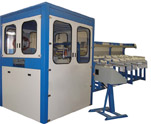 |
GED Integrated Solutions has introduced a new series of fully automated processing machines for repeatable precision fabrication of ready-to-assemble vinyl sash and main-frame window and door parts.
Custom designed and manufactured to meet the specific requirements of today’s vinyl window and door manufacturers, the new GED MCS Multiprocessors utilize advanced electronics from Allen-Bradley and a new linear actuator that ensures precise part positioning and pinpoint fabrication accuracy of sash and main-frame parts. The result of this advanced engineering is maximum output with zero scrap. The MCS Multiprocessors can reduce the number of workers needed for the fabrication process by five to seven, while increasing throughput by up to 30 percent. Users will also benefit from reduced material usage and increased profitability.
The GED MCS Multiprocessors include the new 2000 model for custom in-line fabrication including drilling, punching and routing of vinyl window sash components, and the new 3000 model for in-line fabrication of main-frame vinyl window and door components.
Additional features include: customized fixturing and extruded profile clamping; tailored customer profile software with in-line machine performance monitoring; accurate, repeatable performance during continuous long-term use; maximum operator safety with full floor-to-ceiling see-through enclosure of all automated fabrication tooling and optional lineal preload system to reduce downtime.
Designed and manufactured in heavy-duty welded steel, the GED MCS Multiprocessors utilize a standardized modular building block design that ensures continual long-term operation with minimal maintenance. This design approach reduces lead times for new equipment and ensures quick turn-around on replacement parts.
Custom tape patterns
Window and door manufacturers can now apply lead tape to create unique cut-glass designs at the rate of 100 or more lites per shift, depending on pattern design, with GED’s Decorative Application System (DAS) that includes a X-Y application table and easy-to-use software. The new GED DAS system includes a patented method for accurate inside/out application of two-sided lead panels along with the flexibility to apply 6.0mm, 9.0mm and 12mm width lead tape in 50m and 100m rolls.
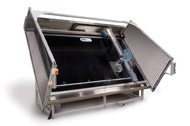
|
CAD compatible, the GED DAS system has an easy-to-use dedicated designer program that permits creation of diamond, grid or frame lead tape patterns at the machine. Custom lead tape patterns can be created from .dxf files and stored with the help of colourful visuals.
In adapting the company’s existing X-Y application table and machine to apply lead tape as well as 3M Accentrim optical film, it was also able to provide window and door customers with an automated application system that produces accurate, consistent, profit generating single and two-sided leaded lites.
DAS performance specifications:
• maximum lite size: 50in by 96in by 1⁄4in (1.27m by 2.44m by 6.35mm)
• minimum lite size: 8.0in by 8.0in (203mm x 203mm)
• 100 lites of lead or 3M Accentrim at production output: 24in by 36in grid pattern. -end-
GED Integrated Solutions: (330) 963-5401, www.gedusa.com
225 windshields per hour
New from Glasstech is a high efficiency windshield system, the EPB-L, which uses a single tooling set to produce as many as 225 windshields per hour and modifications to its cornerstone autoglass processing system, the DB 4.
The EPB-L benefits from Glasstech’s earlier development of the Super Deep Bend forming and annealing system (SDB-L), which produces complex windshields with improved reflective optics, tight tolerances and asymmetrical construction. The SDB-L uses an edge stress system for higher edge compression without increasing the inner band tension. This factor has resulted in lower warranty claims for windshields produced on the SDB-L process.
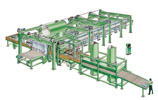
|
Combining the efficiency inherent in the EPB family of systems with the experience gained with the SDB-L creates a system that meets original equipment standards for frameless wiper systems, such as the Bosch ICON standard, and the tighter tolerances required for heads-up display systems.
The EPB-L is energy efficient because only glass and one tool are heated. With the gravity sag windshield process, multiple forming tools are heated and cooled for each windshield. Its single tool set is price competitive and requires much less maintenance and storage room.
The most productive EPB-L system can produce as many as 225 windshields per hour and change jobs in less than 90 minutes. A financial operating model for the EPB-L process shows a financially viable windshield fabrication technology and ensures that future tight-forming requirements are achieved.
Enhanced forming capabilities
Glasstech says modifications to its DB 4 Deep Bend advanced bending and
tempering system for automotive glass has enhanced its forming capabilities and operational efficiencies.
Forming capability increases are the result of the increasing popularity of crossover vehicles. In many designs, glass covers the D-pillar in the rear, making it difficult to maintain tight tolerances. To meet the D-Pillar challenge, researchers developed a patent-pending method of positioning glass on the DB 4 tooling. A new detection system has demonstrated a significant reduction in off-form losses caused by upstream/downstream position variation. This technology can be retrofitted to existing DB 4 systems or ordered as a part of a new system.
New methods have also been developed to increase the surface area produced on the DB 4 by running some parts two-at-a-time, increasing productivity and operational efficiency. This process provides a more efficient use of energy and it reduces the fabrication cost per part. Examples of this approach include narrow backlites that can be run side-by-side and smaller door lites that can run one-in-front-of the other. -end-
Glasstech: (416) 661-9500
Powerfeed for length
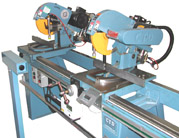
|
CTD Machines has introduced a DM200R 12in double end trim cut-off saw with optional lineal powerfeed for length. The table powerfeed moves the right sawhead via an electric motor. This feed mechanism has hand controls for direction, speed and fine adjustments. It also has a rapid mode for quick movement from one dimension to another. The DM200R comes standard with 2.0hp, three phase motors; magnetic starter; power downfeed of sawheads with air filter, regulator, lubricator; two vertical inside air clamps; 8.0ft centres cutting distance on the rails. Additional lengths are available as an optional accessory. The table powerfeed and digital length readout are also offered as an optional accessory to the standard machine. -end-
CTD Machines: (213) 689-4455, www.ctdsaw.com
Fast and uniform
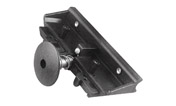
|
LCS-SSN Notcher from LCS Precision Molding is a solution for the small insulated glass producer using Super Spacer. LCS Precision Molding’s LCS-SSN Notcher is designed to make manual corners. Application of Super Spacer is faster and uniform using the LCS-SSN Notcher. This hand-operated tool assures consistent placement of Super Space at 3⁄16in from the glass edge and provides a clean accurate corner notch; it adjusts to fit Super Spacer sizes ranging from 1⁄4in to 13⁄16in and can be sharpened easily with the use of a few shop tools. A slim line Notcher is also available for smaller Super Spacer sizes.
It is complemented by the company’s LCS-SSG Super Spacer Groover tool. The LCS-SSG is used to create grooved spacer for leaded and stained glass panels and is used with Super Spacer silicone foam.
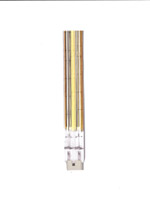
|
Ideally, these notching and grooving hand tools can be used in combination with the LCS suction cup indexing rotary work table (LCS3084.) -end-
LCS Precision Molding: (507) 362-8685
Heat lamps and emitters
Fenestration Products Company is now offering heat lamps in various sizes and configurations for any oven or heating application. The lamps range from Clear Quartz Infrared Heat Lamps to Twin Tube Infrared Gold Coated Emitters. Applications include: GED/Billco Intercept ovens, Swiggle oven, drying ovens, heating and bending. -end-
Fenestration Products Company: (416) 410-3873, www.FenPro.ca
Forms glass in alloy molds
Grieve Corporation has introduced a 1600 degree F (871 degree C) gas-heated belt conveyor furnace, No. 811, that is currently being used for forming glass in alloy molds at a customer’s facility.
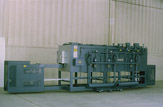 |
Workspace dimensions inside this unit measure 24in wide by 12ft deep by 22in high. Workloads travel atop a 6.0in wide, B-30-28-14, Type 314 stainless steel mesh conveyor belt with 1⁄4hp motor drive, fixed speed 12ft/min, through a 36in long open belt loading zone, 12ft long insulated heat zone with three direct-fired furnaces and a 24in open unloading zone. Three modulating gas burners produce 1,320,000BTU/hr with a floor-mounted combustion air blower.
The 7.0in thick insulated walls comprise 5.0in of 2300 degree F ceramic fiber and 2.0in of block insulation; 61⁄2in thick floor insulation comprises 41⁄2in of 2300 degree F (1260 degree C) firebrick and 2.0in of block insulation. Vertical lift doors at each end of the workspace provide further insulation. A remote free-standing control panel is also included with this Grieve furnace which features all safety equipment standards required for gas-heated equipment.
No. 811 was entirely designed, engineered, built and fully tested by Grieve. -end-
Grieve Corporation: (847) 546-8225, www.grievecorp.com

|
Bending capabilities
JSA Machinery, in Montreal, Quebec, manufactures bending machines capable of covering the many needs of the bending sector. They include hydraulic and electromechanical machines with the application of several control solutions from manual to numerical.
The machines are made up of a robust cast iron structure, shafts in rectified steel, mounted on conical bearings all driven by motor reducer and tempered steel gears.
The increase in bending is provided by the lower rollers, depending on the version, by hydraulic cylinders, motor reducers or manually by endless screws. -end-
JSA Machinery: (450) 658-9668, (877) 575-8665
While Glass Canada editors make every effort to be objective when reporting on new products, they cannot be held responsible for claims made by companies. Readers are encouraged to contact the companies for more details.
Print this page
Leave a Reply